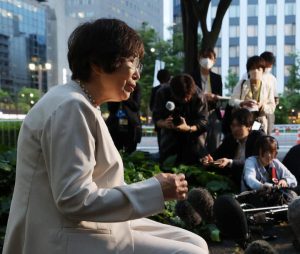Keiko Ogura speaks to G7 leaders about A-bombing experience at age of eight, requests “one step toward a world without nuclear weapons”
May 20, 2023
by Hiromi Morita and Fumiyasu Miyano, Staff Writers
On May 19, Keiko Ogura, 85, an A-bomb survivor and a resident of Hiroshima’s centrally located Naka Ward,met with leaders of the G7 (Group of Seven industrialized nations) in Hiroshima attending the G7 Summit meeting, and their spouses, at the Hiroshima Peace Memorial Museum (also in Naka Ward). Speaking in English, she shared her experience in the atomic bombing of Hiroshima, conveying the horror of nuclear weapons.
Ms. Ogura experienced the atomic bombing at the age of eight near her home in the area of Ushita-cho (now part of Hiroshima’s Higashi Ward), about 2.4 kilometers from the hypocenter. In front of the museum’s exhibits, she described her experience of being engulfed in a flash of light and blown over by the A-bomb’s blast, as well as the scenes of people with serious burns and wounds fleeing the city’s center. center. “I wanted the leaders to imagine what I, as a child, witnessed after the bomb was dropped on Hiroshima and to have a sense of the reality of nuclear weapons,” she said.
To communicate the distinctive nature and inhumanity of nuclear weapons, marked by their use of radiation, she explained instances of the many people who were unharmed at the time of the bombing but died shortly thereafter. She also relayed the story of Sadako Sasaki, a girl who experienced the atomic bombing at the age of two and died of leukemia ten years later, and the folded paper cranes that have become synonymous with her name. The leaders listened attentively to her account and asked for Ms. Ogura’s hand when she had finished her talk.
After the war, she married Kaoru Ogura, who served as director of the Peace Memorial Museum, among other posts, but kept her painful experience in the atomic bombing to herself. After her husband’s death in 1979, she began to serve as an English-speaking guide for visitors to Hiroshima and to work as an interpreter. Around 60 years after the atomic bombing, she spoke in public for the first time about her own experience in the atomic bombing after being asked to tell her story. She continues to share her account with people visiting from overseas.
On that day at the museum, Ms. Ogura spoke openly to the leaders of nuclear weapons states and nations reliant on a nuclear umbrella about her sorrow that the world without nuclear weapons A-bomb survivors have long hoped to see has not yet materialized. “I want the leaders to take one step toward a world without nuclear weapons based on what they have seen, heard, and felt here in Hiroshima,” she said with conviction.
(Originally published on May 20, 2023)
On May 19, Keiko Ogura, 85, an A-bomb survivor and a resident of Hiroshima’s centrally located Naka Ward,met with leaders of the G7 (Group of Seven industrialized nations) in Hiroshima attending the G7 Summit meeting, and their spouses, at the Hiroshima Peace Memorial Museum (also in Naka Ward). Speaking in English, she shared her experience in the atomic bombing of Hiroshima, conveying the horror of nuclear weapons.
Ms. Ogura experienced the atomic bombing at the age of eight near her home in the area of Ushita-cho (now part of Hiroshima’s Higashi Ward), about 2.4 kilometers from the hypocenter. In front of the museum’s exhibits, she described her experience of being engulfed in a flash of light and blown over by the A-bomb’s blast, as well as the scenes of people with serious burns and wounds fleeing the city’s center. center. “I wanted the leaders to imagine what I, as a child, witnessed after the bomb was dropped on Hiroshima and to have a sense of the reality of nuclear weapons,” she said.
To communicate the distinctive nature and inhumanity of nuclear weapons, marked by their use of radiation, she explained instances of the many people who were unharmed at the time of the bombing but died shortly thereafter. She also relayed the story of Sadako Sasaki, a girl who experienced the atomic bombing at the age of two and died of leukemia ten years later, and the folded paper cranes that have become synonymous with her name. The leaders listened attentively to her account and asked for Ms. Ogura’s hand when she had finished her talk.
After the war, she married Kaoru Ogura, who served as director of the Peace Memorial Museum, among other posts, but kept her painful experience in the atomic bombing to herself. After her husband’s death in 1979, she began to serve as an English-speaking guide for visitors to Hiroshima and to work as an interpreter. Around 60 years after the atomic bombing, she spoke in public for the first time about her own experience in the atomic bombing after being asked to tell her story. She continues to share her account with people visiting from overseas.
On that day at the museum, Ms. Ogura spoke openly to the leaders of nuclear weapons states and nations reliant on a nuclear umbrella about her sorrow that the world without nuclear weapons A-bomb survivors have long hoped to see has not yet materialized. “I want the leaders to take one step toward a world without nuclear weapons based on what they have seen, heard, and felt here in Hiroshima,” she said with conviction.
(Originally published on May 20, 2023)








